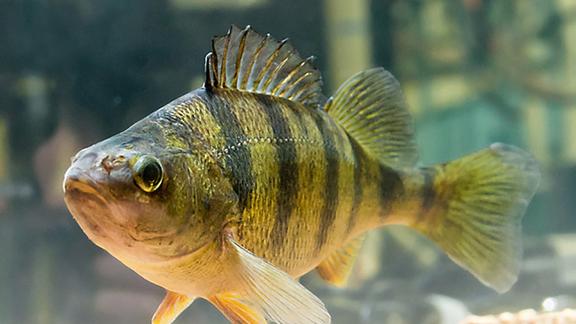Yellow Perch. Image credit: Robert Colletta/U.S.Department of Agriculture, Agricultural Research Service.
The University of Minnesota Sea Grant program is developing producer-scale methods for raising Yellow Perch fish from egg to market size in a recirculating aquaculture system (RAS).
Check out our video-rich February 2023 Extension Column "Aquaculture Project Update: Raising Yellow Perch Indoors."
Read more about this project in "A Firm and Flaky Fish Tale" from MNSG Aquaculture Extension Associate Kieran Smith in our August 2022 Extension Column.
“Many Minnesota fish farmers are looking for a species that has a much higher market value than Tilapia; Yellow Perch might fill that niche,” said Amy Schrank, MNSG fisheries and aquaculture extension educator and project lead. “Minnesota Sea Grant has been actively engaged with Minnesota fish farmers since 2017 and raising Yellow Perch is one of the problems they asked us for help with.”
+
What are Yellow Perch?
Yellow Perch, also known as Lake Perch, are fish found in the drainages of the Atlantic and Arctic oceans, the Great Lakes, and the Mississippi River basin. Yellow Perch flesh has a mild, sweet flavor with firm, flaky white flesh. They are highly sought after by ice anglers, according to the Minnesota Department of Natural Resources.
+
Project description
Why Yellow Perch? Yellow Perch are a highly prized food-fish in the Great Lakes region, from 5-star restaurants to Friday night fish fries. The harvest of wild-caught Yellow Perch has plateaued, yet demand continues to increase (Clapp and Detmers 2004) and there is growing interest in the use of aquaculture to fill this unmet demand. Yellow Perch farms in Minnesota increased between 2013 and 2018, and in Wisconsin Yellow Perch production is second only to Rainbow Trout (USDA Census of Aquaculture 2018). Unfortunately, the supply of fingerlings for aquaculture is limited (Weldon 2019) and this problem was exacerbated by the COVID-19 pandemic (van Senten et al. 2020). “Moving production of Yellow Perch from outdoor pond rearing to indoor RAS could increase overall production, increase growth rates, and expand the season when fresh Yellow Perch fillets would be available to consumers,” said Schrank. “We hope this project will also help increase the availability of biosecure fingerlings that fish farmers need.”
Fish-farm systems: With increased interest in using recirculating aquaculture systems (RAS) and aquaponics systems there is an unmet demand for biosecure Yellow Perch fingerlings (juvenile fish) for grow out in these systems. A few research facilities have experimented with methods for indoor rearing of Yellow Perch and have had anecdotal success, however, methods for rearing in RAS has not yet been developed or accessible at the producer scale (Hart et al. 2006, Weldon 2019). Developing a proven methodology to raise Yellow Perch in RAS would increase production of Yellow Perch in the Great Lakes region by increasing the capacity of the industry to produce market ready Yellow Perch over a prolonged season, and provide the much needed production of biosecure fingerlings for regional producers. In addition, it would allow producers to increase the vertical integration of their businesses in response to supply chain disruptions caused by the COVID-19 pandemic.
Funding: Minnesota Sea Grant's Egg-to-Market Yellow Perch project is funded by a $134,879 grant from the National Sea Grant Office and is one of 13 nationwide projects designed to address ongoing and long-term impacts associated with the COVID-19 pandemic on seafood resources, including aquaculture and the connection between aquaculture and wild-caught fisheries.
Goal: The goal of the Egg-to-Market Yellow Perch project is to develop methods and cost estimates accessible for small- to medium-size producers to hatch, feed-train, and rear Yellow Perch to fingerling and market size in a RAS. These methods should address two of the negative impacts of the COVID-19 pandemic on fingerling supply:
- Increase the supply of biosecure fingerlings for grow out in the Great Lakes region
- Provide farmers the opportunity to increase farm vertical integration.
Objectives:
- Compare Yellow Perch rearing in a (1) flow-through system and a (2) RAS.
- Compare Yellow Perch fish growth, mortality rates, and production costs for both fingerling and market-size fish in a flow-through and RAS.
- Engage with the Little Earth of United Tribes community to provide workforce development opportunities and outreach materials that will support the planned Little Earth Urban Farm aquaponics facility.
- Develop a Yellow Perch producers guide that details best practices and cost estimates for growing Yellow Perch in a RAS.
The two types of indoor fish-rearing systems the project will compare are a flow-through and a recirculating aquaculture system (RAS). The main difference between the two systems is that in a flow-through system the water is not reused and in a RAS the water is filtered and is reused within the tank. The two test systems will be located on the University of Minnesota St. Paul campus.
Timeline: September 1, 2021, to August 31, 2023.
+
Why Minnesota Sea Grant?
The Egg-to-Market Yellow Perch project supports Sea Grant's mission to enhance the practical use and conservation of coastal, marine and Great Lakes resources in order to create a sustainable economy and environment. Specifically, this project supports Minnesota Sea Grant's national and state focus area of sustainable fisheries and aquaculture.
+
What have we done lately?
- August 2024: The Yellow Perch project team continues to fine tune their protocols for hatching and rearing Yellow Perch feed training fingerlings.
- August 2024: Spring 2023 batch of fingerlings have now reached harvest size and processing is underway with our partners at Eddie M’s Seafood located in Plymouth, MN. The processed filets will be used for outreach and educational events to help increase knowledge and awareness of Yellow Perch aquaculture in MN.
- Spring 2024: The YEP team successfully hatched and feed trained a fifth group of fish, which will help to increase MN-based aquaculture by filling an unmet demand for feed trained fingerlings.
+
Participants & audience
The Egg-to-Market Yellow Perch project seeks to serve aquaculture farmers, specifically Yellow Perch producers, in Minnesota and the Great Lakes region.
Project partners include Little Earth of United Tribes and Chad Hebert, program manager at the Little Earth Urban Farm.
+
Funding
Minnesota Sea Grant’s Egg-to-Market Yellow Perch project is funded by a $134,879 grant from the National Sea Grant Office and is one of 13 nationwide projects designed to address ongoing and long-term impacts associated with the COVID-19 pandemic on seafood resources, including aquaculture and the connection between aquaculture and wild-caught fisheries.
+
Project history
2024
- The Egg-to-Market Yellow Perch Project team is currently working with three separate age cohorts and two different geographic strains of Yellow Perch from 1) Green Bay, Wisconsin, and 2) Northeast River, Delaware.
- The Egg-to-Market Yellow Perch Project team continues to sequentially harvest and process adult Green Bay strain Yellow Perch that hatched in April 2022. To do this, the project team transfers the fish into a cold water tank set to 19°C for two days without feed. The fish are then transferred to ice before they are scaled, fileted, packaged, and frozen for food at future aquaculture outreach events.
- A second batch of juvenile Green Bay strain Yellow Perch hatched in April 2023, and have been stocked to grow out for the second round of the Egg-to-Market Yellow Perch Project. They should be ready to harvest by June 2024.
- To mimic natural seasonal cycles, the Egg-to-Market Yellow Perch project team has slowly decrease the water temperature for the Delaware strain Yellow Perch from 19°C to 5°C, where it will stay for ~100 days before being raised again. This process will help them mature, and if all goes well, spawn to create their own offspring sometime within the next two to three years.
2023
- July 2023: The Egg-to-Market Yellow Perch project team partnered with Spark-Y to help develop and share youth educational materials and programming about seafood and aquaculture. The collaboration produced the Cooking Seafood with Spark-Y cookbook, a demonstration video on how to filet a fish, and a cooking demonstration video on how to prepare a fish taco using a recipe from the Spark-Y cookbook and some of the Yellow Perch that the project team has raised in the Minnesota Aquatic Invasive Species Research Center lab.
- Summer 2023: The Egg-to-Market Yellow Perch project team's oldest batch of Yellow Perch have grown out successfully. The project team is in the process of harvesting these fish for food.
- Summer 2023: The Egg-to-Market Yellow Perch project team has three batches of Yellow Perch growing in the Minnesota Aquatic Invasive Species Research Center lab and all are doing well and growing fast.
- May 2023: It's planned that the first batch of embryos that hatched into larvae on April 29, 2022, will be harvested.
- April 2023: A batch of embryos was collected from Blue Iris Fish Farms in Black Creek, Wisconsin, and transported back to the Minnesota Aquatic Invasive Species Research Center (MAISRC) Containment Lab. These embryos are just now hatching and will be used as the second batch of fish in the Egg-to-Market Yellow Perch Project.
- March 2023: Yellow Perch embryos shipped from Delaware arrived at the Minnesota Aquatic Invasive Species Research Center (MAISRC) Containment Lab on March 16, 2023. The embryos hatched into larvae on March 24, 2023, and are now 28 days post hatch and growing fast.
- January 2023: Minnesota Sea Grant Aquaculture Extension Associate Kieran Smith provided a video-rich update on MNSG's Egg-to-Market Yellow Perch Project in MNSG's January 2023 Extension Column "Aquaculture Project Update: Raising Yellow Perch Indoors."
2022
- In April 2022, the first batch of Yellow Perch embryos hatched. While the larvae grew into juvenile fish, a recirculating aquaculture system, or RAS, was constructed to provide a constant and controlled environment for the fish.
- The fish-growing setup for this project has two separate systems. The RAS, mentioned above, and a flow-through system, which as its name implies, has water that flows through it that is not recirculated.
- If you're into do-it-yourself plumbing, you might appreciate this next part:
- Project team members plumbed together a biofilter (technique used to remove, capture or degrade contaminants), a UV (ultra violet) sterilizer, and a 90-gallon-per-minute water pump.
- The biofilter, UV sterilizer, and 90-gallon-per-minute water pump were connected to a sump and two 250-gallon circular tanks.
- Two more 250-gallon tanks were plumbed together as a flow-through system. These are separate from the RAS tanks.
- 1,752 fish were transferred into the four, 250-gallon circular tanks (438 fish per tank) that now form our RAS and flow-through systems for continued growth.
- For this project’s RAS a PolyGeyser biofilter built by Aquaculture Systems Technologies was used.
- Each day a project team member collects data on water quality, temperature, feed, and fish behavior data from all four tanks.
- Every 30 days about 44 of the fish in each tank are weighed and measured to monitor their growth.
Program Staff
Program News
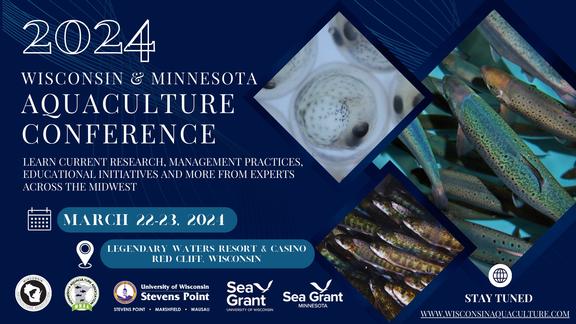
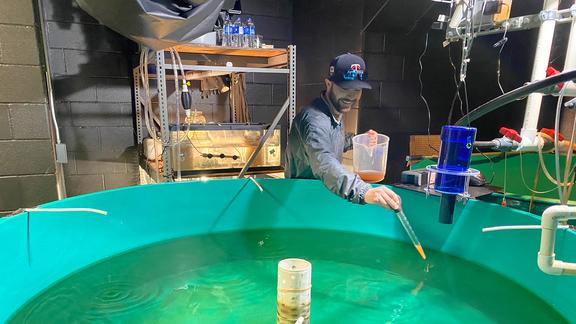
Application Period is Open - Deadline April 14, 2024
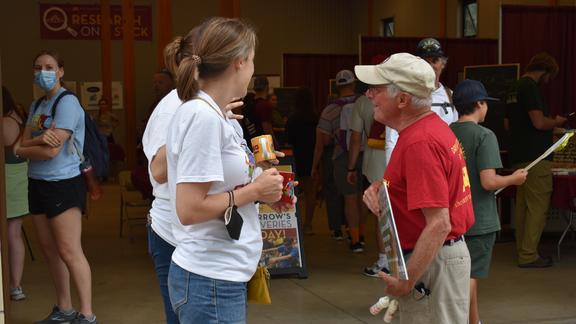
Staff from Minnesota Sea Grant Fisheries and Aquaculture Program will be presenting recent and ongoing projects that addres
Featured Stories
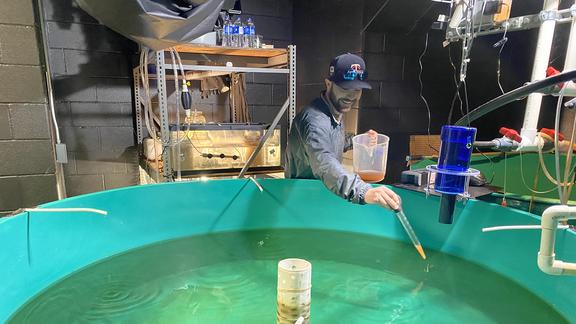
Our January 2023 extension column is by MNSG Aquaculture Extension Associate Kieran Smith and is an update on Minnesota Sea Grant’s Egg-to-Market Yellow Perch Project.
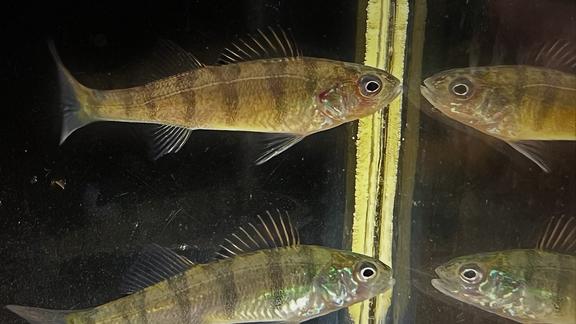
Our August 2022 Extension Column highlights MNSG's Egg-to-Market Yellow Perch project. Above, two Yellow Perch that are less than 2 inches total length, both appearing to wonder who that good-looking fish is in the reflection.
Image credit: Kieran Smith/MNSG
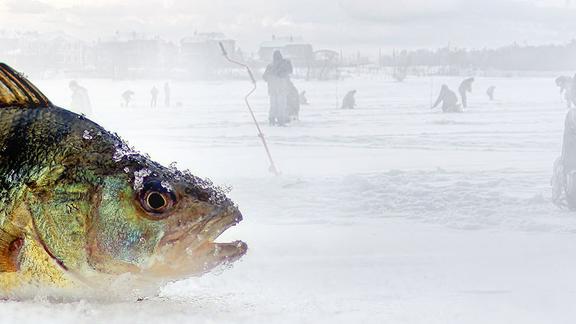
Our three-part March Extension Column highlights Minnesota Sea Grant's annual fisheries and aquaculture student award, project presentations and updates.
Image credit: ©kremldepall - stock.adobe.com
Media Mentions
- Wisconsin and Minnesota Aquaculture Conference Perfectduluthday
- WI-MN Aquaculture Conference Hooks Fish Farmers Morning AgClips
- What women of Sea Grant want: Science is in, spin is out Aquaculture North America

